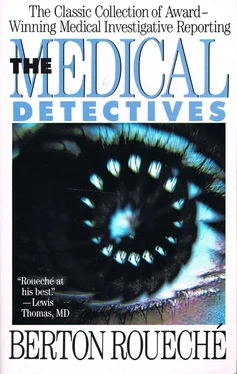"But, of course, we ran the standard laboratory tests. They confirmed Dr. Reiser's diagnosis and the evidence of my own eyes. Her serum copper determination was fifty-eight. Normal is between eighty-one and one hundred and forty-seven. Her ceruloplasmin—a definitive test—was four point six. Normal is between twenty-five and forty-three. Her urine copper was four hundred. Normal is between five and twenty-five. The tragic thing is that her liver involvement had been noted in all of her hospital stays. Noted, but either ignored or misinterpreted. The trouble is, of course, that cases like Carol's, which present both psychological and neurological symptoms, are almost always diagnosed as psychiatric problems. At least fifty per cent of the cases I've seen or know something about were first diagnosed as functional. And a psychiatric diagnosis tends to stick. I fault psychiatry on that. The psychiatrist should not assume that every patient in the six-to-thirty-two age group who seems to be in need of psychiatric help is actually a psychiatric patient. He should stop and consider the possibility of somatic illness. And in a referral, he shouldn't simply accept the previous diagnosis. He should see for himself. I'll go further. I would suggest that all individuals admitted to psychiatric wards between the ages of six and thirty-two be screened for Wilson's disease with a ceruloplasmin test. It's a simple test—all you need is a blood sample. That would save a lot of misery, even lives.
"Wilson's disease has always been a rare disease. I'm sure it always will be. But it is even rarer in another respect. It's not only treatable, it is also preventable. That sets it apart from the great majority of diseases. By preventable, I mean this: If the disease is diagnosed early enough—if treatment is started in good time—then its terrible progression of symptoms can be stopped before they start. That's the point of routine ceruloplasmin testing. Treatment isn't to be confused with cure. There is as yet no cure for Wilson's disease, and none in prospect. It is difficult even to conceive of one. It would require some extraordinary genetic manipulation. The treatment of Wilson's disease is basically very simple and straightforward. The idea is to remove the toxic concentration of copper in the body and prevent its reaccumulation. The first relatively effective therapy was initiated by a group of British investigators in 1948. That was the same year in which the role of copper in the disease was firmly established. The investigators used a chemical, dimercaprol, generally known as Birish antilewisite, or BAL. BAL was developed at Oxford during the Second World War as an antidote to an arsenical war gas called lewisite. It was later found to be effective against other heavy metals, of which copper, of course, is one. BAL was of use in Wilson's disease. I used it for some years. Unfortunately, it has its drawbacks. It is administered by injection, and they are very disagreeable injections—long and painful. And also BAL has frequent severe side effects. The treatment now in use was developed by J. M. Walshe, of Cambridge, in 1956. His paper 'Penicillamine, a New Oral Therapy for Wilson's Disease' is a classic. Penicillamine is a derivative of penicillin, but it's not an antibiotic. It's what we call a chelator. It has the ability to combine with—to bind—a metal. In Wilson's disease, it mobilizes copper from the tissue and excretes it in the urine.
"Penicillamine is truly a life-saving drug. The results can be dramatic. I'm not talking about overnight improvement. But unless the patient has suffered irreparable destruction, the damage can be repaired. Little by little, the liver returns to normal, the Kayser-Fleischer rings fade away, and the neurological manifestations disappear. The standard regimen combines penicillamine and potassium sulfide. Potassium sulfide acts to prevent the absorption of copper by forming an unabsorbable copper sulfide in the gut. Since penicillamine is a treatment rather than a cure, it is continued for the lifetime of the patient. Potassium sulfide is usually discontinued within six months or a year. We started Carol on therapy on April 11—twenty milligrams of potassium sulfide three times a day and one gram daily of oral D-penicillamine in three equal doses. She responded well. The first notable change was the disappearance of her so-called psychiatric symptoms. They departed as soon as she learned the true nature of her trouble. In less than a month, she was doing well enough to continue her convalescence at home, and I discharged her on May 8. I saw her as an out-patient at intervals through the rest of 1973. I readmitted her for a week of thorough evaluation on December 2. She had continued to progress satisfactorily, and I discharged her. Here's what I mean by satisfactory. I'll read you a few lines from her discharge summary. 'Patient is currently without specific complaint referable to disease, and she has improved dramatically since March, when her disease was discovered and she was placed on penicillamine therapy. Her only residual of the disease is a limp on the right and some mild dysarthria and an occasional tremor, usually brought on by anxiety states.' Dysarthria means slurred speech. Her recovery was really impressive.
"I was also impressed by her emotional recovery—her character. Carol had had two years of college in California before her first marriage. She went back to school in January of 1974. She enrolled at the University of Utah here. Not only that. She soon began doing volunteer work at the hospital, and then she got a part-time job, as a file clerk with the Bureau of Land Management of the Department of the Interior. She met Michael Terry there, and they were married in June of 1976, and in December she got her degree. And moved to Washington. I see her once a year, though. She was here just a few months ago, visiting her parents. I'm not sure that her walk and her speech will ever be entirely normal. We'll just have to wait and see. But when I remember the way she looked the first time I saw her. . ."
"Well, yes," Mrs. Terry told me the last time we talked. "I've thought about a malpractice suit. I'm told I have a good case.
Those psychiatrists—I wouldn't wish them on my worst enemy. But then—I don't know. I guess they're only human. So I think I'll live and let live."
[1979]
CHAPTER 23
The Fumigation Chamber
A woman I'll call Betty Page was awakened in the middle of the night, around three o'clock on the morning of Wednesday, May 30, 1984, by a spasm of nausea. She sat up with a lurch and a groan. Her husband, Lewis, lifted his head and asked what was the matter. She told him. She said she didn't understand it—she just felt sick and awful. She crouched there, wondering. Then she had an impulse. She had a sudden craving for milk—for a cup of warm milk. She went down to the kitchen and put some milk in a pan on the stove to heat. She drank a steaming cupful, sipping slowly, cautiously. She began to feel better. She went back to bed and fell asleep, and slept until morning.
The Pages live in a comfortable fieldstone house in Jenkintown, Pennsylvania, a pleasant suburb of Philadelphia. They also have a weekend cottage on a lake in northern Pennsylvania—a three-hour drive from their home—and a condominium apartment in Aspen, Colorado. Betty Page is a small woman, grayly blond with blue eyes and a wide, smiling mouth, and in May of 1984 she had just turned fifty-seven. Lewis Page—big, bald, serenely poised—was sixty. The Pages are both physicians. Lewis Page (Harvard College, the University of Pennsylvania School of Medicine) is an obstetrician and gynecologist in private practice. Betty Page (Wellesley College and Temple University School of Medicine, where she was elected to Alpha Omega Alpha, the Phi Beta Kappa of medicine) is an internist, and at that time was an assistant professor of clinical medicine at the University of Pennsylvania School of Medicine. She is now, and has been for three years or more, on leave from her academic duties. And for good reason.
Читать дальше












